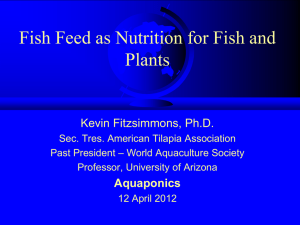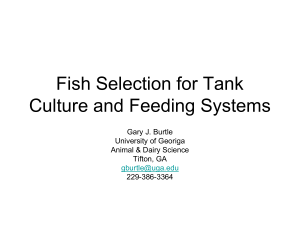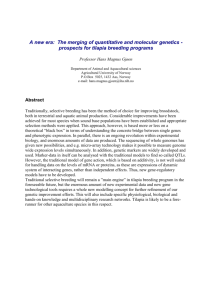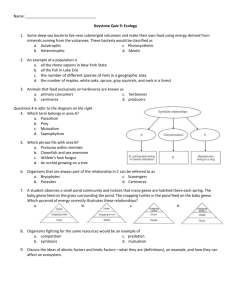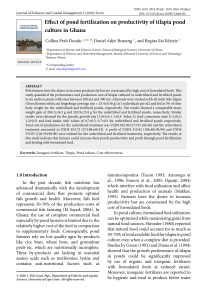Economic Gains to Fish Farmers Resulting from Research Conducted
advertisement
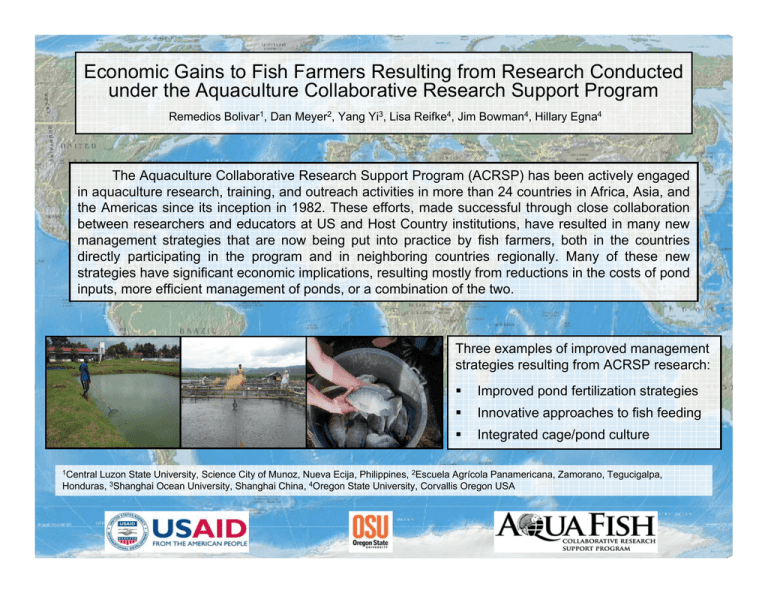
Economic Gains to Fish Farmers Resulting from Research Conducted under the Aquaculture Collaborative Research Support Program Remedios Bolivar1, Dan Meyer2, Yang Yi3, Lisa Reifke4, Jim Bowman4, Hillary Egna4 The Aquaculture Collaborative Research Support Program (ACRSP) has been actively engaged in aquaculture research, training, and outreach activities in more than 24 countries in Africa, Asia, and the Americas since its inception in 1982. These efforts, made successful through close collaboration between researchers and educators at US and Host Country institutions, have resulted in many new management strategies that are now being put into practice by fish farmers, both in the countries directly participating in the program and in neighboring countries regionally. Many of these new strategies have significant economic implications, resulting mostly from reductions in the costs of pond inputs, more efficient management of ponds, or a combination of the two. Three examples of improved management strategies resulting from ACRSP research: 1Central Improved pond fertilization strategies Innovative approaches to fish feeding Integrated cage/pond culture Luzon State University, Science City of Munoz, Nueva Ecija, Philippines, 2Escuela Agrícola Panamericana, Zamorano, Tegucigalpa, Honduras, 3Shanghai Ocean University, Shanghai China, 4Oregon State University, Corvallis Oregon USA Improved pond fertilization strategies: Tilapia production in Honduras using fertilization Traditional fish farming methods in Honduras were based on empirical information and research results transferred north to south, resulting in relatively low productivity. Most extension agents made educated guesses to assist farmers in pond management practices. ACRSP research results were generated locally and provided science-based guidelines for fertilizing ponds and making a profit in small-scale fish farming in the region. Testing of alternative fertilization strategies 150 day-long trials in 1000m2 ponds with all-male fish stocked at 2/m2 Water temperatures ranged from 23 to 29ºC (av. ± 25ºC) Several fertilization regimes were compared Chicken litter (kg/week) Total cost $/kg of live fish Net return $/ha/year Only chicken litter 1000 0.22 800 Chicken litter + chemical fertilizer 750 0.72 3787 Chicken litter + feed 500 0.73 3022 0 0.84 1965 Production strategy Only feed Results Tilapia production increased with the addition of more chicken litter and the use of specialized feeds Lowest production costs were observed for fish reared with only chicken litter Net returns were greatest for the combination of chicken litter and chemical fertilization, followed by the combination of chicken manure and feed The strategy based solely on feeding fish with a 25% crude protein diet resulted in greater production costs and reduced profit under Honduran conditions Recommendations Farmers will benefit by fertilizing their tilapia production ponds with 500 to 1000 kg of dry chicken litter/ha/week during the first two or three months of grow-out. They can then begin offering a specialized fish feed for the remaining months of each grow-out cycle. Innovative approaches to fish feeding: Typical tilapia feeding strategies in the Philippines The use of supplemental feed in addition to fertilization in tilapia farming has improved tilapia yields economically, but feed costs often comprise 60-70% of the total production cost. This expense may make the difference between profitable and unprofitable culture enterprises. Testing of alternative feeding strategies Three on-farm trials were conducted, each consisting of two ponds in each of seven farms. Each pond was fertilized with inorganic fertilizers at the rates of 28 kg N + 5.6 kg P/ha/week The ponds were stocked with sex-reversed Nile tilapia fingerlings at a density of 4 fish/m2 Results Our investigations have provided three clear options for reducing feed costs in tilapia farming: 1. Delaying feeding onset 2. Sub-satiation feeding 3. Alternate-day feeding strategy Did not significantly reduce the production of tilapia Feed costs decreased by US$595/ha in a five month period The reduction of feed to 67% of satiation had no effect on growth or yield of tilapia Profit increased by US$1046/ha and cost of feed was reduced by US$553/ha in a four month period Saving on feed costs by more than 50% compared to daily feeding No statistically significant reduction in fish production Environmentally desirable due to reduced organic loading Integrated cage/pond culture: Typical cage culture practices Cage culture typically uses artificial feeds and high stocking densities, resulting in high production and high economic returns Cages are generally placed in open systems such as rivers, reservoirs, lakes, and the sea Testing of alternative strategies in Thailand The study used two 4-m3 cages suspended in a 330-m3 production pond Cages were stocked with large Nile tilapia (around 100 g) at 50 fish/ m3, while the ponds were stocked with small Nile tilapia (around 20 g) at 1.4 fish/ m3 Technologies Gross Yield (kg/ha/yr) Net Yield (kg/ha/yr) Net ret urn (US$/ha/yr) CM alone (125 kg/ha/wk) 2,965 2,502 1,117 CM+Urea+T SP (75 kg CM, 28 N+7P) 7,578 7,271 1,955 Urea+TS P (28 N+7 P) 7,110 6,439 1,733 Continually supplemental feeding (Urea+T SP+0.5 Feed) 18,374 17,714 1,551 Staged supplemental feeding (Urea+T SP+0.5 Feed) 19,539 18,952 5,029 Feed alone 19,574 18,901 -2,198 Cage-cum-pond 25,214 19,179 6,578 Results There were higher gross and net yields of tilapia (kg/ha/yr), and higher net returns (US$/ha/yr) for tilapia cage-cum-pond culture than for traditional mixed-size pond culture practices. Integrated cage/pond culture is: Economically advantageous An ideal culture system for small-scale farmers Environmentally friendly Good for stocking high-valued species in cages

